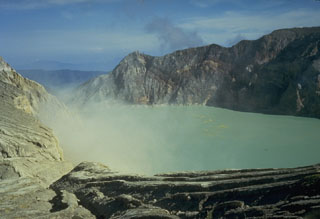Report on Ijen (Indonesia) — 10 July-16 July 2024
Smithsonian Institution / US Geological Survey
Weekly Volcanic Activity Report, 10 July-16 July 2024
Managing Editor: Sally Sennert.
Written by JoAnna G. Marlow.
Please cite this report as:
Global Volcanism Program, 2024. Report on Ijen (Indonesia) (Marlow, J G, and Sennert, S, eds.). Weekly Volcanic Activity Report, 10 July-16 July 2024. Smithsonian Institution and US Geological Survey.
Ijen
Indonesia
8.058°S, 114.242°E; summit elev. 2769 m
All times are local (unless otherwise noted)
Pusat Vulkanologi dan Mitigasi Bencana Geologi (PVMBG) raised the Alert Level at Ijen from 1 to 2 (on a scale of 1-4) at 2200 on 12 July (local time). The recommended exclusion zone radius was expanded from 500 to 1,500 m away from the crater due to a notable increase in seismic energy, as well as an increase in continuous tremor amplitudes. Realtime seismic amplitude measurement (RSAM) analysis has shown that seismic energy has slowly increased since 1 January 2023. However, a significant increase in energy was observed from 1700 through 2100 on 12 July, along with an increase in continuous tremor amplitudes starting at 2110. From 1 June through 12 July there was a decreasing trend in the number of both shallow volcanic earthquakes (Type B/vulkanik dangkal) and deep volcanic earthquakes (Type A/vulkanik dalam), while the number of other types of earthquakes fluctuated normally. On 30 June the surface temperature of the crater lake water was 34°C, which falls within the normal range. Weak to moderate fumarolic activity was observed, characterized by dense white emissions. The color of the water appeared turquoise green, as usual, with no visible gas bubbles on the surface of the lake. The smell of sulfur gas was moderately strong, and sulfur spherules were observed at the edge of the crater lake. White emissions were observed rising 50-100 m above the summit on 10, 12-13, and 16 July, and 50-200 m on 14 July. Emission observations were not reported on 11 or 15 July. Seismicity during 10-16 July included daily gas emission events and continuous tremor, volcanic earthquakes during 13-16 July, and a volcano-tectonic (VT) earthquake on 16 July. PVMBG reminded the public to stay vigilant of the potential for poisonous gases emanating from the crater lake.
Geological Summary. The Ijen volcano complex at the eastern end of Java consists of a group of small stratovolcanoes constructed within the 20-km-wide Ijen (Kendeng) caldera. The north caldera wall forms a prominent arcuate ridge, but elsewhere the rim was buried by post-caldera volcanoes, including Gunung Merapi, which forms the high point of the complex. Immediately west of the Gunung Merapi stratovolcano is the historically active Kawah Ijen crater, which contains a nearly 1-km-wide, turquoise-colored, acid lake. Kawah Ijen is the site of a labor-intensive mining operation in which baskets of sulfur are hand-carried from the crater floor. Many other post-caldera cones and craters are located within the caldera or along its rim. The largest concentration of cones forms an E-W zone across the southern side of the caldera. Coffee plantations cover much of the caldera floor; nearby waterfalls and hot springs are tourist destinations.
Source: Pusat Vulkanologi dan Mitigasi Bencana Geologi (PVMBG, also known as CVGHM)

